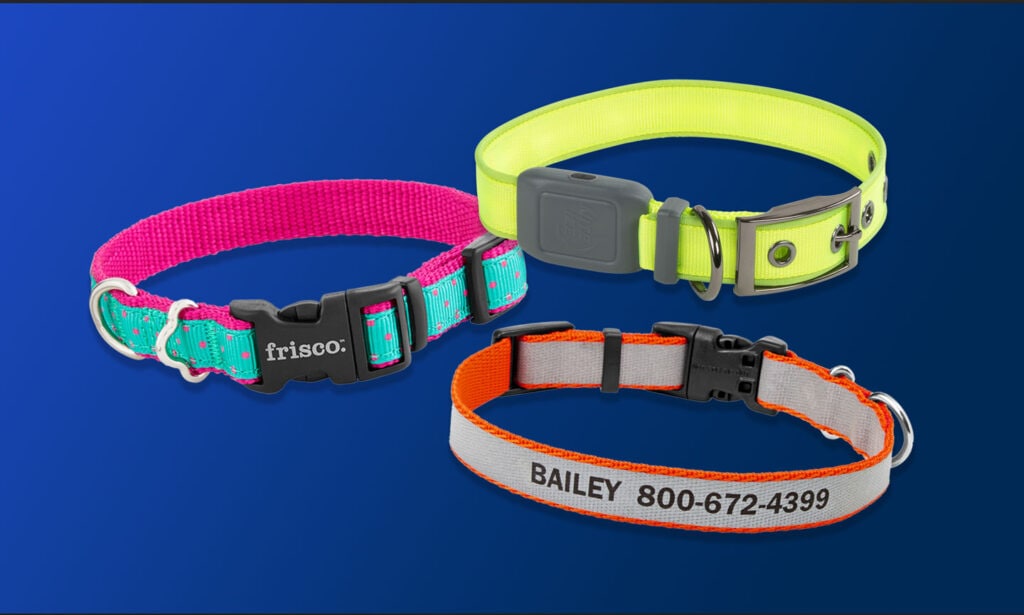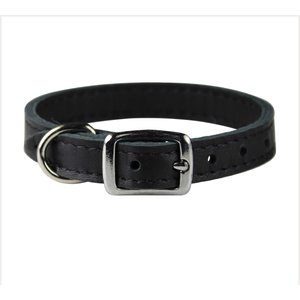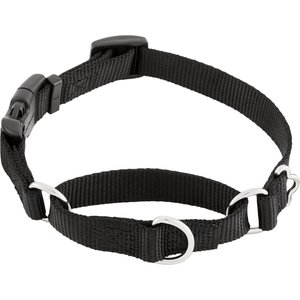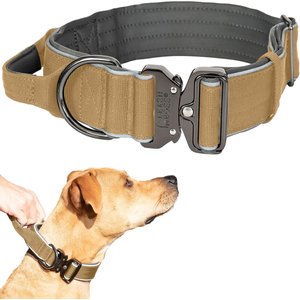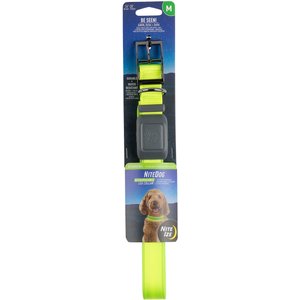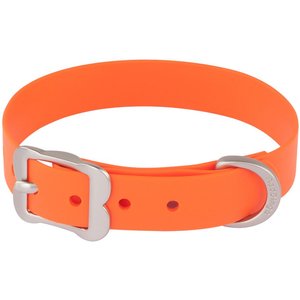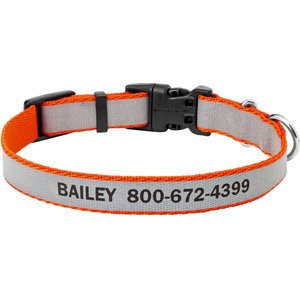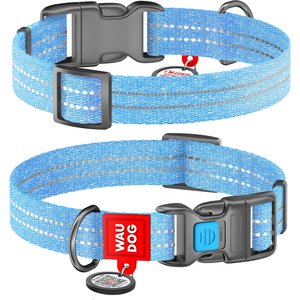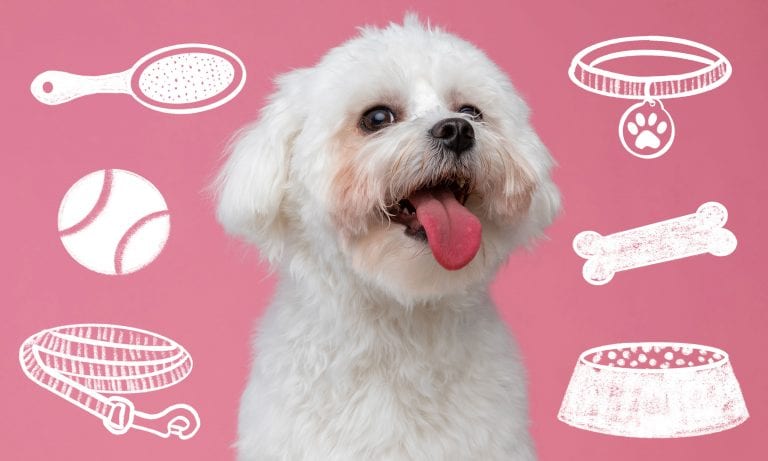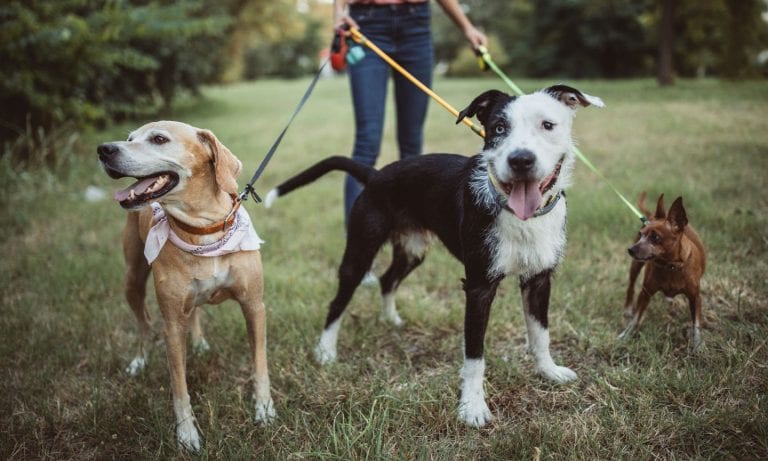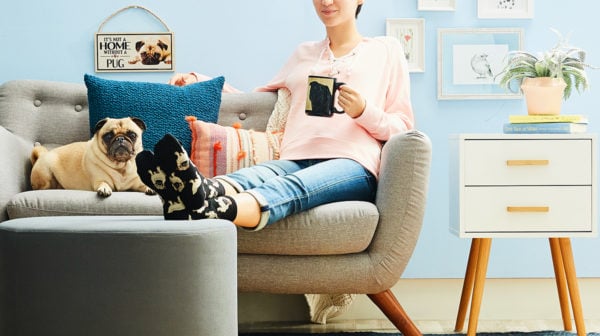The humble dog collar. You might think it’s just a basic accessory, but dog collars serve many important purposes.
Your dog’s collar holds your dog’s ID tag, which can help get them home should they run away. You can use it to attach your dog's leash, providing a safe way to take them on their daily walks. It can even help your dog be seen better at night. Of course, it’s also a fashion statement—a way to express your and your dog’s unique personalities.
Picking the best dog collar for your individual pooch can make all the difference in your daily lives. To help you choose the best dog collar, we spoke to certified dog trainer Irith Bloom, CPDT-KSA, and then assembled a group of trainers and editors to carefully review 21 of Chewy’s best-selling and best-rated dog collars, putting them to the test in real-world conditions with 10 dogs.
During testing, collars were rated on the following criteria: fit, functionality, durability, ease of use, and attractiveness.
-
1
Best Overall Dog CollarBlueberry Pet 3M Multi-Colored Stripe Polyester Reflective Dog Collar $20 on Chewy
- 2
- 3
- 4
- 5
Best Overall Dog Collar
This stylish dog collar from Blueberry Pet is made from polyester webbing, features a side-release clip for easy on and off, and has 3M reflective strips woven into the fabric for nighttime visibility.
“The Blueberry Pet collar is the perfect balance of function and fashion,” says Chewy Senior Editor Kristine Cannon, one of our testers. “For us, the way the collar looks is just as important as durability and functionality, and the Blueberry collar is a sturdy and stylish collar that has it all.”
During the testing period, Cannon’s 3-year-old "super mutt,” Odesza, wore the collar on her daily 30-minute morning walks and a trip to her cousin’s house for a playdate.
Smart design choices that really impressed Cannon included: the 2 D-rings (one for Odesza’s ID tag and one for her leash when she wasn’t wearing her harness) and the placement of the D-rings next to the clip closure, so the clip was always positioned on the back of the neck instead of under the neck during walks, thus putting less strain on the clip.
Its on-trend olive and blue-gray color combo and reflective striping for visibility also helped give it a leg up over other collars.
The fit was true-to-size, though Cannon notes that the metal tri-glide slide can get caught on the material, which can make it difficult to adjust the size. “However, the upside is this ensures a secure fit‚ and we haven't had to adjust the collar since,” she says.
Though it lacked the thicker mesh padding of some other collars, its construction was solid, and Cannon says Odesza seemed very comfortable wearing it.
“Overall, it's a truly beautiful, well-made collar that's sure to get compliments from other pet parents,” she says.
Things To Consider: Two D-rings; true-to-size, secure fit; reflective; trendy colors; solid construction; and not heavily padded.
-
Reflective dog collars
I love these collars. Double D-ring leash hooks feel safer relieving the pressure on just the collar latch. Also, the separate tag loop keeps their tags from tangling with the leash hook. I have a couple extra collars for each of the 2 dogs just to be sure we're never without.
-
A quality collar!
I am happy with this collar. It's a hefty, well stiched material with double d rings for added security. I definitely recommend this pretty collar.
-
Stand Out Collar
We love how comfortable it seems for Mabel our Pomsky. Even with all the fur, it fits and clasps well! The reflective part definitely stands out in the middle of the night so we can see her in the yard!
Best Leather Dog Collar
Leather dog collars are known for their durability, and the OmniPet® Signature leather collar was no exception. Cannon, who tested this collar with 45-pound Odesza, describes it as an attractive, no-frills collar that is strong but surprisingly lightweight and flexible.
“It's more than a pretty collar; we're even considering bringing this along with us on her next hiking adventure,” she says.
In fact, it was its lighter construction that made it “super-wearable” and helped push this collar into the top position for this category.
“The collar is lighter in weight and more flexible than we thought it'd be, especially when compared to other high-quality leather dog collars that have extra padding,” Cannon says.
Made from 100% genuine leather, it features a traditional buckle closure and one D-ring. Though Cannon appreciated the tough nickel hardware, she would prefer two D-rings.
That said, she usually only uses Odesza’s collar for her ID and opts for a harness to attach to her leash, making the one D-ring less of a concern.
It fit true-to-size, but Cannon says it’s important to read the size guide closely and pay particular attention to the adjustable length listed.
For Odesza’s 17-inch neck, she selected the 18-inch collar, which has an adjustable length of 11–15 inches, but she says she should’ve chosen the next size up, which has an adjustable length of 14–18 inches. Though the 18-inch collar fit Odesza on the very last notch, this may not be ideal for pet parents with dogs who are still growing.
Things To Consider: 100% genuine leather; well-made, sturdy construction; lightweight; fits true-to-size but pay attention to adjustable length; and one D-ring.
-
Leather dog collar
It made from a good quality leather. Our dog wore it many times during the rain and it managed to keep it's quality.
-
Exactly What I Was Looking For
I wanted a simple, red-colored leather collar for my 12-lb. Mini Poodle, and this fits the bill perfectly. I ordered the 14". It may be a TINY bit large; but, not outrageously so. The collar is a little stiff; but, I'm sure it will soften with wear. Overall .. very satisfied.
-
Decent collar for a puppy
Decent collar. I bought the 16” for my 10 week Dalmatian girl (she weighed about 14 lbs at the time) and it fits. She is now 4 months/24 lbs and I had to expand 1 hole but still fits well. I just wish the ring to which attach the leash to was bigger
Best Martingale Dog Collar
Martingale collars for dogs are ideal for escape artists who tend to slip out of standard collars, because they tighten when pulled. They’re especially well-suited for dogs with narrow heads, like our tester Paul Bujold’s smooth-coated Collie, Gemma.
Gemma wore the Frisco® by Chewy martingale collar during a two-week testing period, and Bujold reports it functioned well.
“We went on about 20 walks and the collar worked perfectly,” says Bujold, a professional dog trainer. “In no time at all, neither of us thought about it much.”
In addition to walks, Gemma hiked, visited the beach, played ball and Frisbee®, and romped with other dogs.
Bujold gave the nylon collar high marks for being easy to use and well-made, noting that it was both lightweight and flexible yet strong. He also appreciated that the plastic clasp made it easy to attach and take off, and it was unobtrusive.
Things To Consider: Sturdy yet lightweight construction; easy to use; true-to-size fit and easy to adjust; and two D-rings.
-
Replaces 2 chewed collars!
We learned to remove the collar each time, along with the leash, to avoid chewing opportunities! How smart are we. It only took 3 additional purchases.
-
Quick release!
This is our second one of these - we had one for our older dog and wated one for our younger corgi. This collar has held up nicely. I like Martingales. I like the quick release for safety and It's easy to put on!
-
A more comfortable dog collar
This collar is made really well, and offers more comfort than the tight collar I used to keep my dog from slipping out of it. This one gives her a little room to breathe. And I love the red color!
Best Small Dog Collar
When it came to finding the best small dog collar, fit was a major area of concern for dog mom and Chewy Senior Editor Ciara LaVelle. In the past, she’s had issues with collars staying snug on her 14-year-old Chihuahua-Miniature Pinscher mix, Zeno.
The small-size patterned collar from Frisco® by Chewy won her over with its secure fit, among other desirable attributes.
Though it took a bit of strength and time to adjust the collar’s size, once the adjustable slides were set, LaVelle says it did not budge for the entire testing period, which for this senior pup included 30- to 45-minute daily walks plus leisurely play with the family.
“The secure straps are definitely an upgrade from previous collars we've had, which needed to be re-tightened regularly,” LaVelle says, adding the difficulty in adjusting the sliders may be a challenge for an elderly pet parent.
When selecting the best size for Zeno, she was pleased to find that the sizes overlapped. This, she says, is ideal for dogs who tend to be in between sizes, like Zeno.
For example, the extra small collar is for dogs with 8–12 inch necks, while the small is for dogs with 10–14 inch necks. Zeno, who has an 11-inch neck, fit perfectly in a size small.
Another big plus was the second ring for ID tags. The additional ring meant not having to double up on one ring with both the ID tags and leash. Its special design, which is similar to a standard D-ring but with a bump-out in the center, helped reduce jangling noises.
“It doesn't totally eliminate the sound of her tags, but I definitely noticed a difference compared to other collars we've had, especially on walks,” LaVelle says.
The nylon material makes for a durable collar, and it stayed clean and bright, though LaVelle admits she is not the biggest fan of the polka dot grosgrain ribbon, which is a bit too cutesy for her taste.
“It's not my specific style, but the other aspects of the collar make up for it,” Lavelle says. “She's still wearing it!”
Things To Consider: Secure, true-to-size fit, once adjusted; overlapping sizes ideal for dogs in between sizes; two D-rings; durable, well-made construction; and limited patterns to choose from.
-
Cute and girlie. bright colors.
Got this for my chiweenie. Shes looks adorable. Fits great. Seems well made. She was excited when we put it on.
-
Cute and durable
Very thick material. Some of the cheaper collars are made of thin material and the collars loosen over time/ with play. These stay tight and don’t loosen. Super cute
-
Stays put
This stays put and doesn't get loose. Also, I like that it has a loop for the leash and a separate loop for dog tags. Very sturdy and stays where I adjust it, unlike some other nylon collars that slip get loose.
Best Dog Collar for Large Dogs
The large and extra-large sizes of Leashboss®’s collar adjusts up to 31 inches in length and comes in two widths, 1.5 inches and 2 inches, to fit big dogs. Features include padded lining for comfort, a handle for more control, a large metal D-ring, and a heavy-duty metal buckle.
Our dog tester, Stella, a 72-pound Great Pyrenees-Shepherd mix, wore the large size, 1.5-inch width collar every day, except at night when sleeping.
Stella’s mom and Chewy Managing Editor, Bre South, says the collar is “extremely well made” and held up well during all her energetic, 3-year-old pup’s activities, which included playing Frisbee®, running around the backyard, and twice daily 1-mile walks.
Though South used Stella’s regular dog harness to attach to the leash, she especially appreciated the collar’s handle, which she used to help hold Stella back during excitable moments.
“Stella gets very excited when she sees other pups, and we're still trying to get her to sit down when she's excited,” South says. "It helped to have an extra handle to secure her back.”
The metal, quick-release buckle was another standout feature. While a bit on the heavy side, it was “more functional than her previous plastic buckle collars.”
The addition of reflective piping was a nice touch, providing better visibility during evening walks.
Things To Consider: Sturdy and durable for big dogs; padded handle for better control; reflective; durable, quick-release buckle; buckle may be too heavy for dogs with smaller necks; one D-ring; and limited color choices.
-
Heavy Duty
Heavy duty dog collar. Love that there is a handle on the leash its self to grab and control the dog quickly. Heavy duty leash rings. Very reflective.
-
Leash boss tactical dog collar
Works great for my extra large shepherd . Easy on dog whom is a puller when on leash ! Less neck trauma when he pulls . Very sturdy , well made collar w/extra buckles & a strong hand loop . Well worth the money
-
Very nice quality and good sizing
Very nice quality and finish. With it being bigger then the normal Collars I get the dog doesn’t pull with it as much. Nice grab bar for when I need to keep the dog away from things
Best Light-up Dog Collar
Collars that glow or light up help make you and your dog more visible to motorists during early morning or nighttime walks.
The Nite Ize® dog collar, made with optical fiber and two high-powered LED lights, provided exceptional brightness for tester South, who also tested this collar with her dog, Stella.
“It has great color intensity and kept Stella visible during early morning and dusk walks,” South says, adding that it also performed well in the rain.
There are two lighting modes—one static and one that flashes. A big bonus was that it comes pre-charged so your dog can wear it right out of the packaging, though South notes that it does not come with a USB charger.
That means you’ll have to provide one on your own when the rechargeable battery dies, which according to the manufacturer typically is after six hours of usage.
Aside from the visibility factor, South also found the collar to be well-made with thick fabric and a metal buckle; sturdy yet comfortable enough to wear all day; and easy to adjust, thanks to the five buckle notches.
Our tester highly recommends it for pet parents who do a lot of camping with their dog and/or who take their walks closer to evening and early morning, “especially those of us on the East Coast who have longer winters.”
Things To Consider: Intense brightness for visibility in darkness; easy to use and can be used immediately‚ due to fully charged battery upon arrival; durable, well-made construction; true-to-size fit and is easy to adjust; no USB cord included for when you do have to charge it eventually; two light mode options; and limited color options.
-
Nice and bright!
This collar is nice and bright. Good for night walks or finding them in a dark yard. Easy to buckle, unlike some of the snap on ones Sturdy enough to be used as a stand alone collar, not as an addition to your regular collar, making you dog wear two.
-
Good night time visibility
Great collar for evening walks and just to see the dog in the backyard. Con is it doesn’t come with charger.
-
Nite Ize Dog Collar is a best collar.
Nite Ize Dog Collar is the best thing I have Experience. To keep the dog safe at night time. So cars can see them and people. That is why I bought them for my dogs. So I can keep an eye on them too when I let them loose to run at night time. Thanks for customer assistance for helping me find the collar for them for night time. I got them for my two dogs Max and Rodger.
Best Waterproof Dog Collar
For adventurous, water-loving dogs (we're looking at you, Labs!), you can't get much better than this Red Dingo® collar. Made from durable PVC-coated webbing, it’s waterproof and easy to clean—just a couple of the reasons why it took the top spot for our tester, Maria Christina Schultz.
And Schultz knows a thing or two about adventurous, water loving dogs. A certified dog trainer, she regularly goes stand-up paddle boarding with her dogs—and even teaches other dog parents how to do it.
For this test, her 4-year-old Australian Shepherd, Willow, wore the collar 24/7 for over a week, which included daily walks, games of fetch in the backyard, hikes, and two SUP outings on the river.
“This collar is a great value,” Schultz says. “It does what it says and it's competitively priced.”
In addition to the collar’s waterproof and stink-proof properties, its construction won her over with its strong-but-lightweight design and the fact that it held its shape during all the activity.
While she’s a fan of the collar’s bright color, she did find the number of color options a little lacking. She also would prefer a quick-release buckle for water-based play in case the collar ever gets caught on something.
The D-ring for attaching ID tags and a leash was a bit on small side, but Schultz says that probably means it’s less likely to be caught on something, like a tree branch, which is especially ideal when in the water.
Things To Consider: Completely waterproof; stink-proof; sturdy construction; bright colors; traditional buckle closure may not be ideal for water-based activities; and one (smaller) D-ring.
-
This is a good and strong collar.
This is a very strong collar for Axel my baby Golden Retriever. He is terrible strong and pulls a lot on me when I walk him. Glad to have a strong collar.
-
My girl looks girly and professional
Seems like my jock of a springer spaniel wouldn’t break this one. Plus I think the bright pink will pass for hunting pink.
-
Perfect!
I have a mature Beagle who is happiest when he's dirty digging. Most collars are difficult to clean but this one is rubbery and easily washed with Dawn and water. Great price, well constructed and color is bright.
Best Collar for Dogs Who Pull
Head collars are designed to help give pet parents more control over dogs who pull on the leash.
Made from strong-but-lightweight nylon webbing, the Halti® Headcollar features a padded neoprene noseband for comfort, adjustable straps, reflective elements, and a safety strap, which attaches to the dog's collar.
Head collars require up-front training for both the dog and dog parent, but our tester, Vic Gasser and her dog, Dougal, already had a lot of experience using one. Dougal wears one normally, and Gasser is a certified dog trainer.
During the full week of testing, which included twice daily, 45-minute walks, Gasser says the Halti Headcollar made it much easier to turn Dougal's head away from triggers, and it helped decrease his pulling.
“He is very persistent and was still able to pull at times—those darn squirrels! But this made it much easier to get back control,” Gasser says.
The overall fit seemed just right too. Gasser reports that Dougal was able to open his mouth fully while wearing it, but it never slipped off and he wasn't able to paw it off.
She especially liked the width of the strap that goes over the nose, because it didn’t dig into Dougal’s skin when he pulled.
It also was easy to get on and off. “My boyfriend usually struggles putting head collars on but found this one was the easiest to use,” she says.
Another standout feature was the safety strap that clips to the collar. Gasser says it gives you a sense of extra security, though she notes that the clip was on the smaller side, and if you have a big dog who wears a big collar with a big D-ring, it may not be able to clip it on.
The color options are limited—only red or black, which Gasser felt were a little too “aggressive” for her taste. “Not a look I want for my pittie!” But overall, the functionality, fit, ease of use, and durability were top-notch.
Things To Consider: Decreased pulling; easy to get on and off; thick and sturdy straps; safety strap with (smallish) clip to attach to collar; and limited color options.
-
Halti Collar
I had ordered the wrong size (too small) and you sent me the correct size and I donated the wrong one to a pet shelter as per your request instead of having to send it back.
-
great concept
well my pup being a 3 yr old Jack Russel Mix she shuts down and fights me. I have not given up trying it and working with her just gonna take time and patience. I've been care taking several other pups and she does well walking and not pulling but soon as were free I'll work with her.
-
Perfect for training
Our golden retriever pulled constantly on walks until we got this! He’s a year old now, but I wish we had been using it all along. Works brilliantly!
Best Personalized Dog Collar
Being able to print your dog’s contact info directly on their collar offers several benefits, like never having to worry about their ID tag falling off and no more of that familiar jingling of the tags.
This personalized dog collar from Frisco® by Chewy allows you to add one line of text to include your dog’s name and your phone number.
Our tester, longtime dog mom and pet industry expert Melissa Kauffman, reports that the personalization was easy to do. Just type in the info you want, up to 24 characters long.
She was pleasantly surprised at how well the custom-printed text fit on the size small collar. Even when she adjusted the collar's fit, the adjustable slider did not rest on the text, though the manufacturer warned her that it might.
Murphy Brown, a Chihuahua-Miniature Pinscher mix, wore the collar daily on romps in the backyard as well as walks through the neighborhood and on local trails.
Kauffman says the collar, made from durable polyester webbing, fit and held up well, and she especially liked its reflective properties and the two D-rings for leash connection and tags.
The sporty aesthetic and colorful border garnered the custom dog collar high marks for appearance, though Kauffman says she wished the reflective strip came in more collars than gray.
Things To Consider: Easy personalization; sturdy, durable construction; reflective; two D-rings; sporty look; true-to-size fit; and ray is the only color option for reflective material.
-
The quality of the collar!
Ever since my dog was a puppy always had the personalized Frisco collar . The quality is much better then other brands.
-
Easy to read
Nice collars and I feel safer with them in them. They are easy to read, even on the smaller dog size.
-
Great idea
I love that this is reflective and has all my info on it. Inalso think should my dog ever get out it would be helpful doe anyone who spotted him to know his name and hopefully he would respond to them.
Best Budget Collar
Coming in at under $10, the WAUDOG QR Passport dog collar is a very practical collar with some special bonus features.
Made from re-claimed cotton, it comes in 10 colors, sports reflective stitching, and has a safety lock on the side-release clip. But perhaps one of the biggest standouts is the QR code that comes on the included tag.
You can use the QR code (and a special mobile app) to create a pet profile. Should your pet ever go missing, whoever finds them can scan the code to get your pet’s contact info. When they do, you’ll immediately receive a notification with the dog’s location.
Our tester, Melissa Kauffman, chose to use both the QR code and her dog Murphy Brown’s regular ID tag for added security. She was concerned some people may not be tech savvy enough to use the QR code should they ever come across a runaway Murphy.
This also meant she had to put both the leash and regular ID tag on the one D-ring since the ring for the QR code was too small to hold the ID tag.
The collar itself is lightweight and sturdy, and Kauffman says it functioned well when attached to the leash during long trail walks almost daily.
As you might imagine, the collar got plenty dirty during walks and outdoor playtime, but Kauffman says it was easy to clean. “Even if it gets wet, it dries easily, and also washes well if it gets muddy,” she says.
In fact, she recommends it for dogs who like hiking and get their collar dirty.
Things To Consider: Eco-friendly; “smart” tag with QR code; safety lock on side-release clip; dirt washes off it easily; lightweight yet sturdy; and comes in 10 great colors and has reflective stitching.
-
The Fit
The fit was perfect! I didn't need to adjust the collar at all for my pugs. Just measure around the neck and the sizing is perfect.
-
Pretty in Pink
The collar fit well and looked pretty on my dog. It cleans up easily with a little soap and hand washing.
What To Look for in a Dog Collar
Fit
You don’t want a collar to be so big that your dog can slip out of it, but you don’t want it to be too tight either. To ensure the best fit, measure the circumference of your dog’s neck and then compare that measurement to the size guide provided by the collar manufacturer.
Be sure to take into account the ranges of sizes if the collar is adjustable, and follow any special instructions from the manufacturer (for example, some may suggest you add 1–2 inches to your dog’s neck size to ensure a comfortable fit).
When you put the collar on, make sure you can fit two finger widths between the collar and your dog’s neck.
Functionality
Dog collars are designed for different functions. Think how you will be using it, and choose accordingly. For example, will it be used to attach your dog’s leash, just for the ID, or both? If both, you may want two D-rings. Are there any special uses you may need to consider? For example, if you’re an earlier riser who takes pre-dawn walks, you may need a collar that lights up for better visibility in the dark.

Dog tester Willow goes paddleboarding with her family while wearing the Red Dingo dog collar. Photo courtesy of Maria Christina Schultz.
Durability
Odds are your dog will be wearing their collar every day all day, or most hours of the day. It needs to stand up to daily activity, the elements, and possibly chewing. A collar’s durability will depend on the quality of materials and its construction, both in the band itself and the hardware.
Generally speaking, leather is often favored for its durability, though synthetic materials like nylon and BioThane® are also known to be hard-wearing.
Metal hardware may be less prone to breakage than plastic hardware.
Ease of Use
At a most basic level, you should be able to easily put on and remove the collar. Collars come equipped with different types of hardware for attaching them, from traditional buckles to side-release clips. Make sure the one you pick works for you.
Also, as noted above, collars serve a variety of purposes, like holding ID tags, preventing dogs from pulling, and lighting up. Read product descriptions and make sure you are aware of how to use the collar properly. Look for features that can help make life easier, such as extra rings to hold both leash and ID tags, an extra handle for control, or light-up collars that come fully charged.
Attractiveness
Because collars come in many different materials and patterns, it’s a great opportunity to show off your and your pet’s personality. Don’t just ask yourself if you like how it looks, consider how it feels, as well, since you may need to grab it from time to time in an emergency.
How We Tested
We started with 21 of Chewy’s best-selling dog collars that came highly rated by Chewy customers—the ones dog parents like you love the most. Each one was tested for at least one week. During the trial period, the dogs and their pet parents went about their normal daily activities. The pet parents then rated the collar on the above attributes. They also took notes on their experience and filled out a questionnaire.
Testers included:
- Paul Bujold, CPDT-KA: Bujold is a professional dog trainer with The Sophisticated Dog and is based in Ventura, California. He tested collars with his dog Gemma, a 3-year-old, smooth-coated Collie.
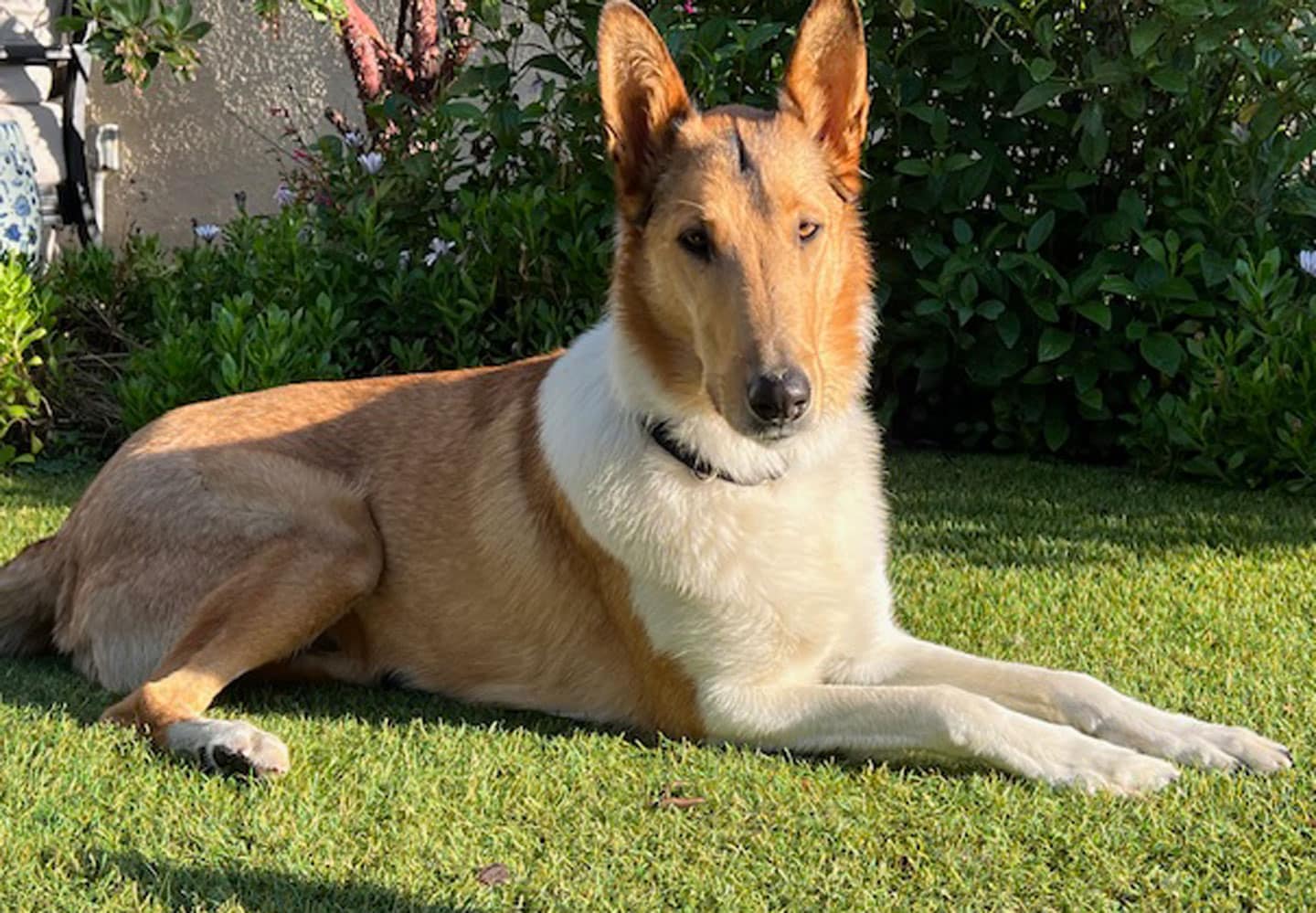
Gemma testing the Frisco martingale collar. Photo courtesy of Paul Bujold.
- Vic Gasser, CPDT-KSA: Gasser is a professional dog trainer with The Sophisticated Dog and is based in the San Fernando Valley, California. She tested collars wither her dog, Dougal a 7-year-old American Pit Bull Terrier mix.
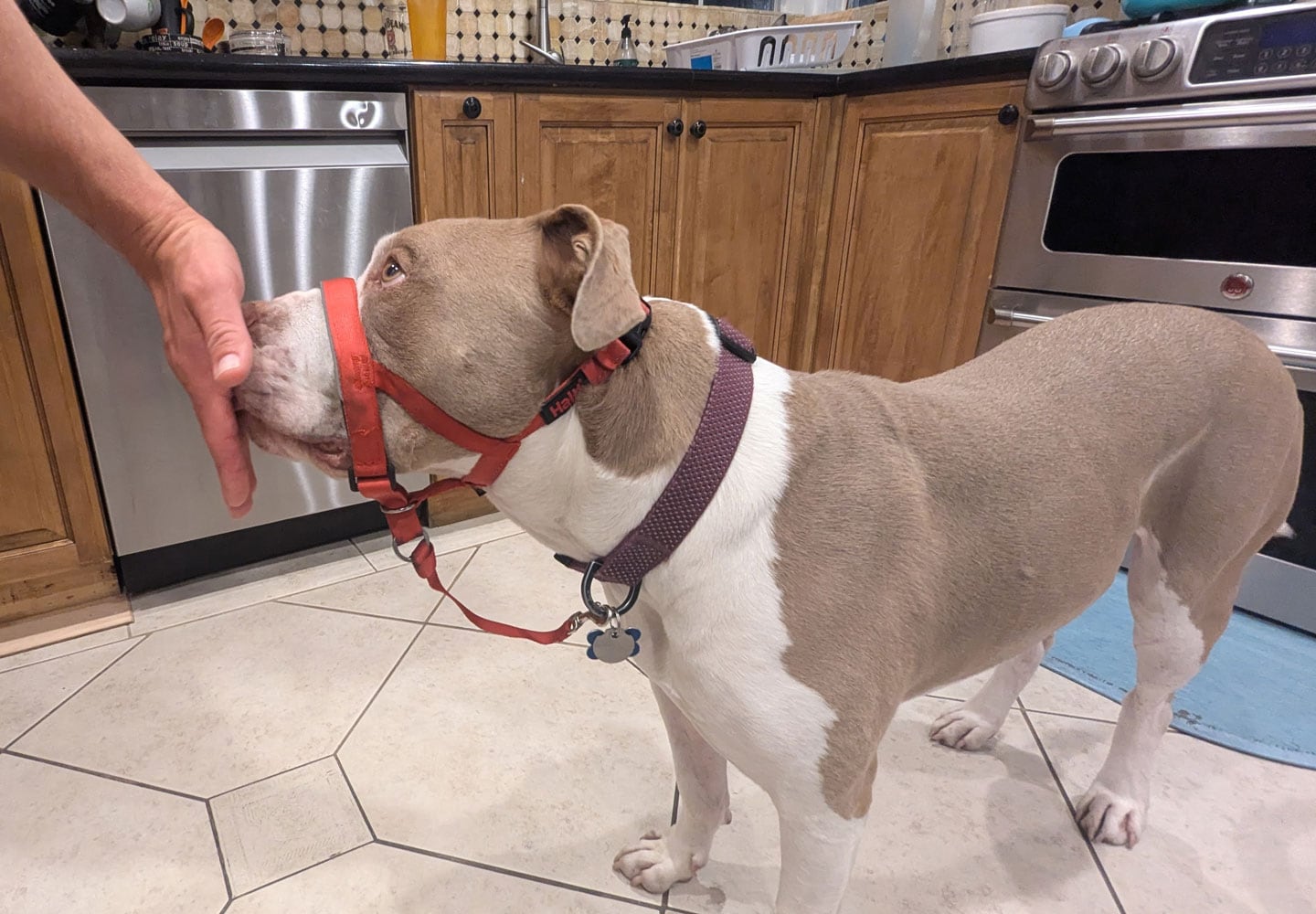
Dougal patiently poses while wearing the Halti headcollar. Photo courtesy of Vic Gasser.
- Maria Christina Schultz: Schultz is a Virginia-based professional dog trainer and certified stand-up paddleboard instructor who teaches pet parents how to SUP with their pups. She tested collars with her water-loving Australian Shepherds, Willow, 4, and Bodie, 5.

The Red Dingo Vivid PVC dg collar, seen here on Willow, was found to be both waterproof and stink-proof. Photo courtesy of Maria Christina Schultz.
- Ciara LaVelle: LaVelle is a Chewy editor who has been covering pet care and lifestyle topics for five years. She tested collars with Zeno, a Chihuahua–Miniature Pinscher mix who, at 14 years old, is a sweet and spunky senior.
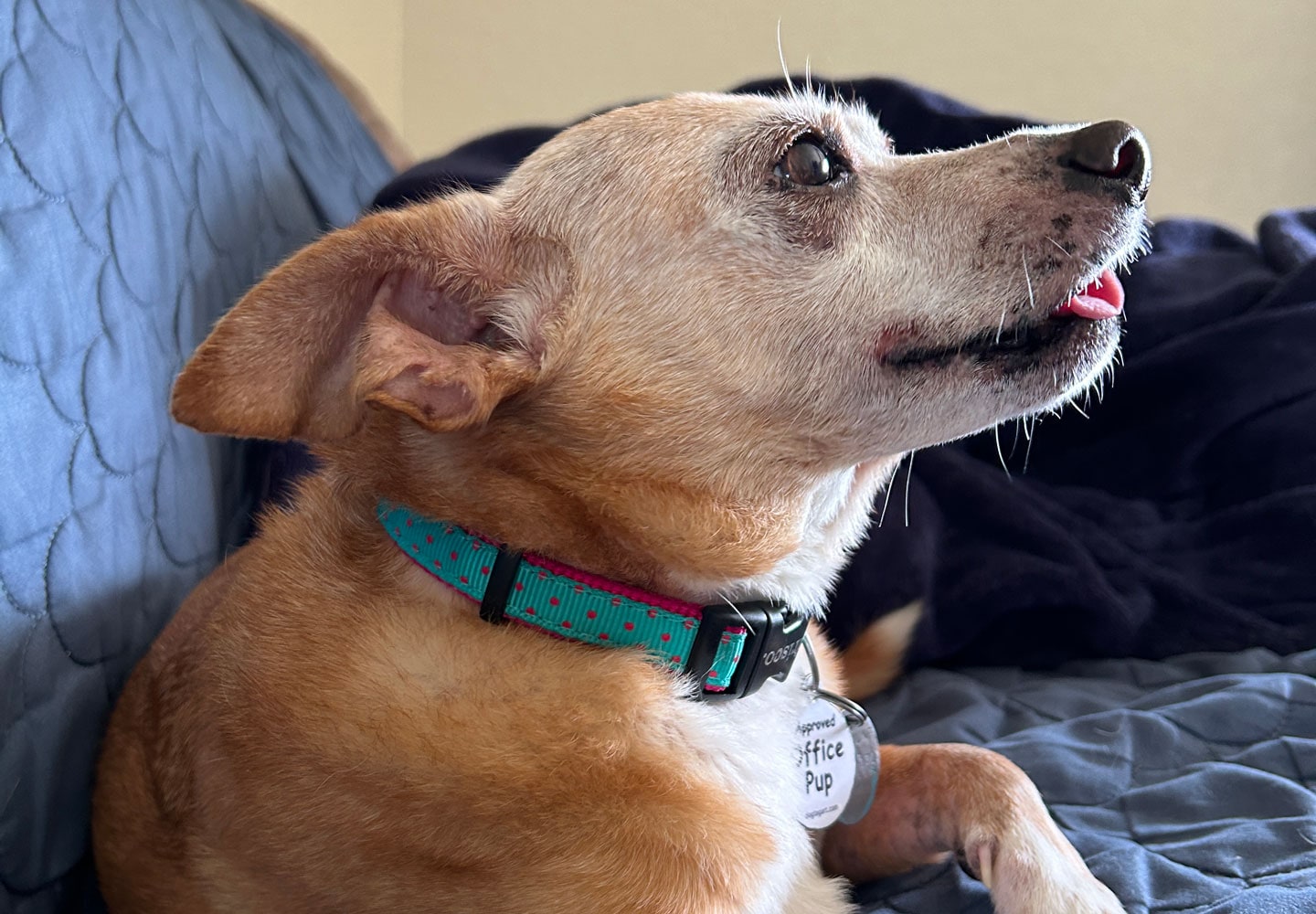
The Frisco Patterned Nylon Dog Collar fit dog tester Zeno true-to-size. Photo courtesy of Ciara LaVelle.
- Kristine Cannon: Cannon is a Chewy editor who has covered pet hard goods and fashion trends for two years. She tested collars with Odesza, aka Dez, 3-year-old “super mutt.”
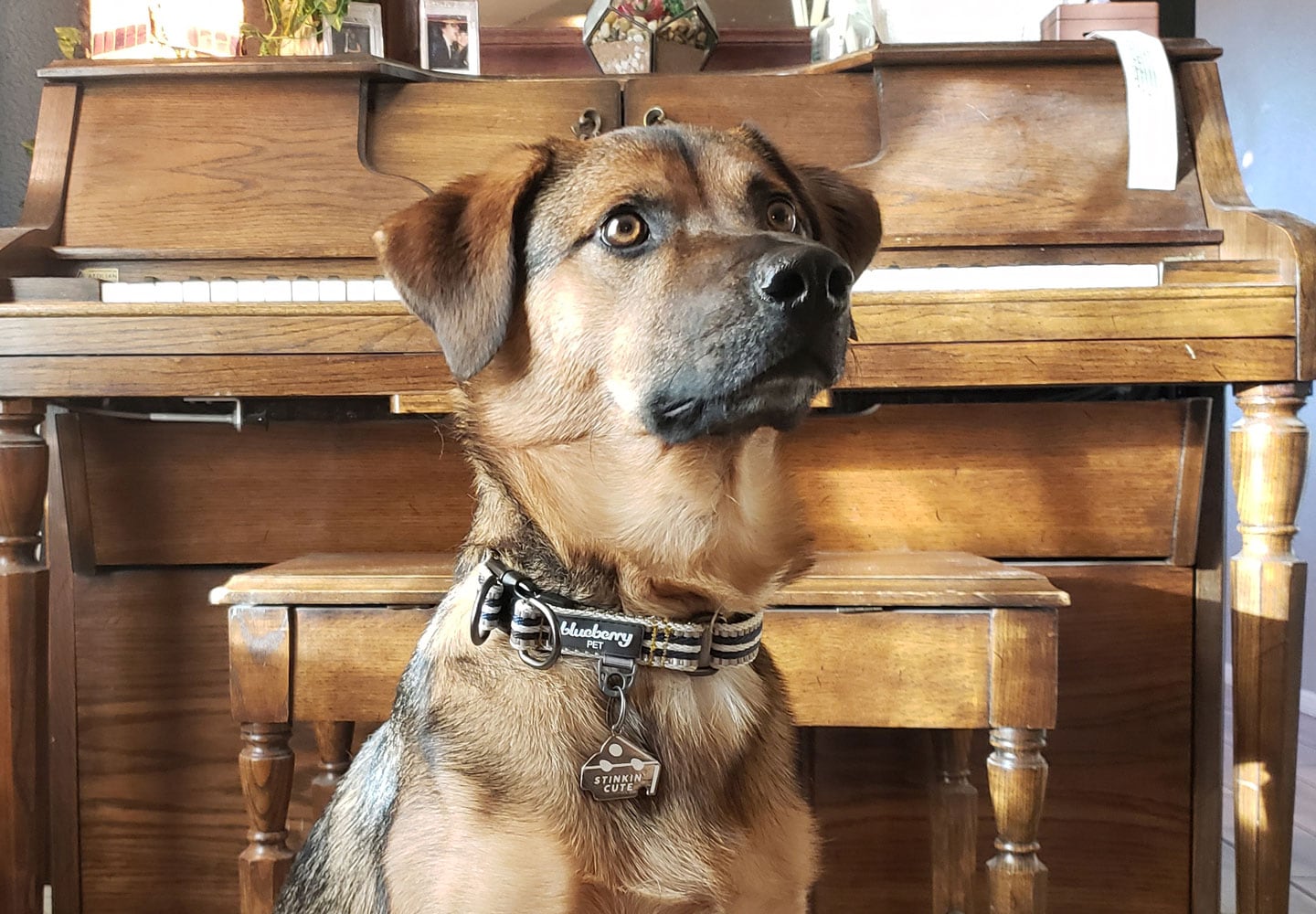
The Blueberry Pet dog collar, seen here on Odesza, was selected as the best dog collar overall thanks to it fit, design, and style. Photo courtesy of Kristine Cannon.
- Bre South: South is a Chewy editor who has written and edited pet health articles and shopping guides for three years. She tested collars with her dogs Ezra, a 13-year-old Labrador Retriever mix, and Stella is a 3.5-year-old Great Pyrenees mixed with several shepherd breeds.

Stella waits to go out for an evening walk while wearing the Nite Ize LED dog collar, which won best light-up collar. Photo courtesy of Bre South.
- Melissa Kauffman: Kauffman is a longtime editor with more than 25 years’ experience in the pet industry. She regularly attends pet product trade shows and has tested hundreds of pet products throughout her career. She tested collars with Murphy Brown, 8-year-old Chihuahua-Miniature Pinscher mix, and Liberty Belle, a 3-year-old Cirneco dell’etna.
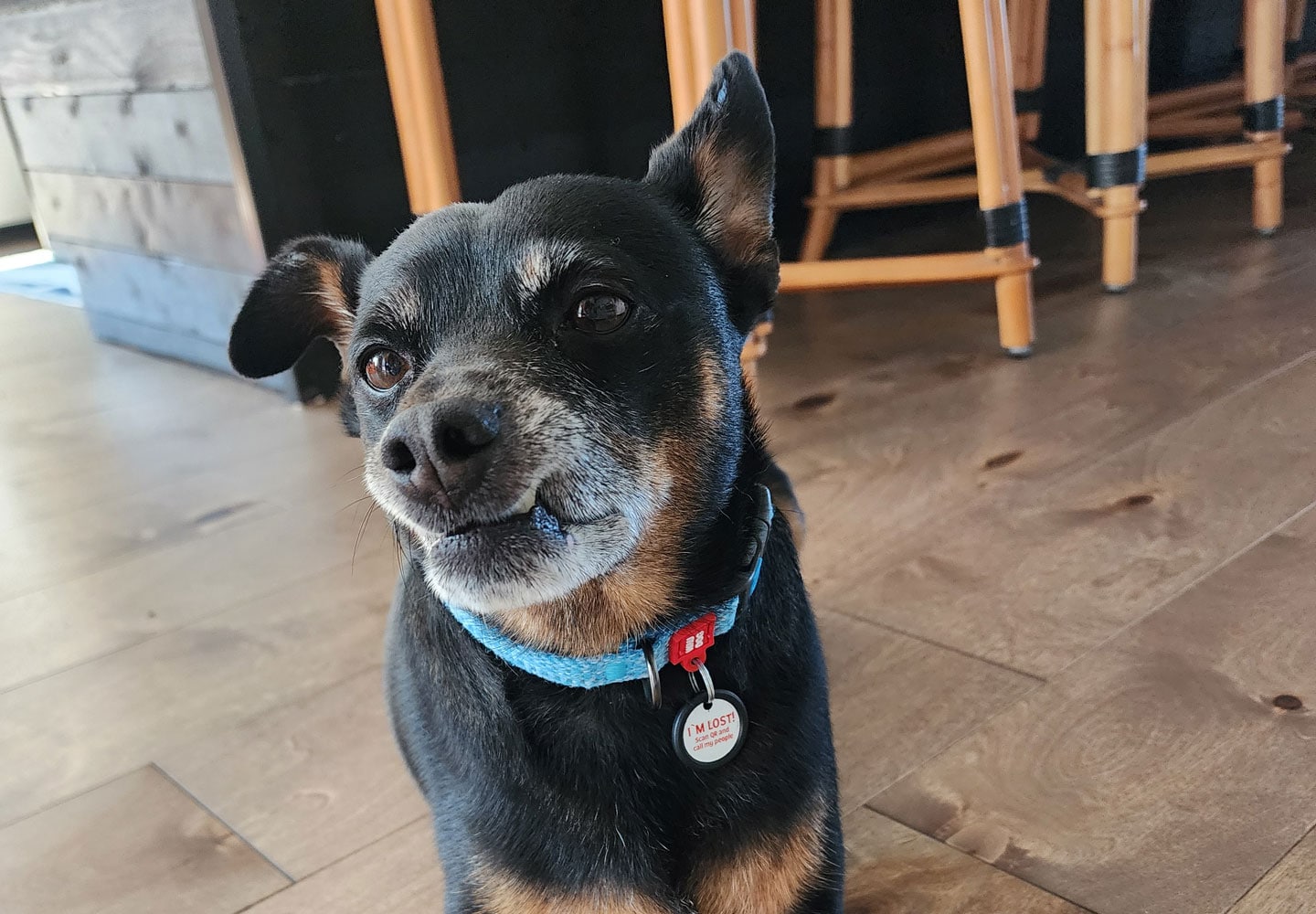
Dog tester Murphy Brown smiles while sporting the the best budget collar from WAUDOG. Photo courtesy of Melissa Kauffman.
Buying Guide: Understanding the Different Dog Collar Types
Standard Collars
Standard collars can be flat or rolled, like a rope, and attach via some type of buckle, including a traditional buckle like you see on belts, side-release clips, or quick-release buckles. They usually have one or two D-rings where you can attach your dog’s ID and collar.
Variety is the key word for these collars—they come in a variety of materials, including nylon, cotton, and leather (more on leather collars below), plus various colors and patterns.
Rolled collars are usually recommended for dogs with long hair, like Afghan Hounds and Shih Tzu, and more specifically, long-haired show dogs, because the rolled collars tend to be gentler on the coat, dog trainer Bloom says.
That said, you want to select whichever one—flat collar or rolled—your dog is most comfortable wearing.
The same goes for the collar’s material. Some dogs’ skin may be easily irritated by different materials, Bloom says, so you want to pick one that is comfortable for your dog.
“I’d say for 99% of dogs, it won’t make a difference, but there is that small number of dogs where it really does help for them to have a specific type of material, because their skin is really easily irritated,” Bloom says.
If you opt for a side-release clip instead of a traditional buckle, Bloom says to test it to make sure it fully and securely closes, and that you can easily snap and unsnap the clip to take the collar on and off. This is especially important for older people or pet parents with arthritis.
Leather Collars
A type of standard collar, leather collars come in both flat and rolled versions, and a variety of closures, though you’ll typically see traditional buckles. They tend to be durable and last a long time, potentially decades, Bloom says.
However, they may require periodic conditioning, don’t tend to come in as many colors or patterns as collars made of nylon or cotton, and, when wet, need to be removed and dried.
Bloom says she is a big fan of leather collars and typically uses them for her own dogs.
“A good quality leather collar will last forever,” she says. “They look great, and most dogs will find them comfortable.”
Waterproof Collars
Like the collars above, waterproof collars have a variety of closures, ranging from traditional buckles to quick-release. The main difference is they’re made from a waterproof material, like PVC or BioThane, which makes for quick drying, easy cleaning, and less odor.
These collars are best for dogs who like to swim, live in wet climates, and like a good romp in the Great Outdoors.
Light-Up Collars
Simply put, these are collars that light up so the dog can be seen when it’s dark outside. They look a lot like regular collars but are typically equipped with LED lights powered by rechargeable batteries.
Bloom likes these collars for the obvious safety reasons. They allow you and your dog to be seen by motorists while out for walks in the dark, whether early morning or at night. They also allow you to see your dog in the backyard when it’s dark out. And should your dog ever get away from you, the illumination may make it easier to see where they’ve run off to.
Martingale Collars
Martingale collars have a loop in the middle that’s attached to a ring on either side. This loop can tighten when the dog pulls on the leash.
The proper use of a martingale collar is to prevent the dog from slipping out of the collar. “That’s the only proper use of it,” Bloom says.
These are especially handy for certain breeds whose head is roughly the same size as their neck, like Greyhounds (whose heads are as slim as or slimmer than their necks) and bully breeds (whose necks are quite large, nearly the same size as their head.)
That said, Bloom says it could be worth trying on any breed who habitually slips their collar.
To make sure you get the correct size, Bloom says there should still be room for the dog to breathe when you pull the loop to its tightest point, i.e., the rings on either side are touching.
“Maybe not quite two fingers because that may allow the martingale to slip over the head,” but you don’t want it to choke the dog, she says.
“It’s like this delicate balance,” Bloom explains. “You want the martingale not to choke them when fully tightened, but you also don’t want it so loose when it’s extended that it falls off their head when they put their head forward.”
Headcollars
Headcollars have two loops: one that goes around the back of the head, behind the ears, and one that goes around the dog’s snout, or muzzle—similar to a horse halter.
They’re designed to help give pet parents more control over dogs who pull on the leash by gently steering the dog in the right direction. Bloom tends to recommend these to pet parents who are smaller than or close in size to their dog, because they may be at risk of being pulled and/or falling if their dog takes off running.
Training is a must as the dog needs to get acclimated to having a collar on their face.
Also, pet parents need to be careful not to jerk the leash, because Bloom says that will cause the dog’s head to whip around, which could potentially injure the dog.
She recommends following the manufacturer’s instructions and watching their instructional videos.
“If the dog starts to move away from you, you just hold the leash steady and the head collar will do the work,” she explains. “You do not need to do the work with your arms. That’s where you run the risk of injuring the dog.”
Since a head collar should only be worn when out on walks, Bloom still recommends putting a regular collar on the dog so you can attach the ID.
A dog harness may be a good alternative to head collars for some dogs who are strong pullers. “If I have dog who is pulling really hard, I don’t look for a collar solution, I look for a body harness,” Blooms says.
Her favorite is the Freedom no-pull harness, which has a front ring to attach the leash to during training and back ring that can be used once the dog has learned not to pull and walks normally.
Dog Collars FAQs
Q: What is the best collar for a dog to wear?
A: The best dog collar depends on your dog and your specific needs. Generally speaking, a collar should fit well (you should be able to fit two fingers between the collar and your dog’s neck), be comfortable to wear, be durable with a secure clip or buckle (that you can easily operate), and have a D-ring for holding your dog’s ID tag. For dogs who have a tendency to slip out of their collars, a martingale collar may be best. For nighttime- or early-morning walks, a light-up collar may be ideal.
Q: Is a flat or rolled collar better for dogs?
A: Rolled collars are usually recommended for dogs with long hair, especially long-haired show dogs, because they are gentler on the fur. They also may be ideal for a dog with sensitive skin.
Q: Which dog collar is best for preventing pulling?
A: head collar may be a good choice for dogs who pull. They’re designed to gently steer the dog in the right direction. However, for dogs who are strong pullers, Bloom recommends a harness with a front ring to attach the leash to during training.
Learn more about dog-walking essentials:
Share:
